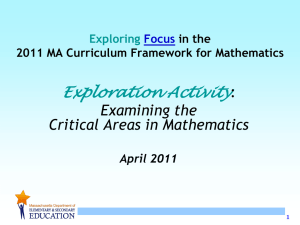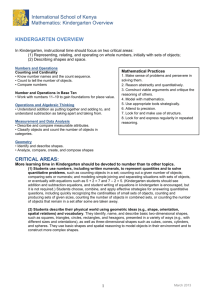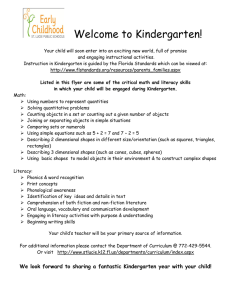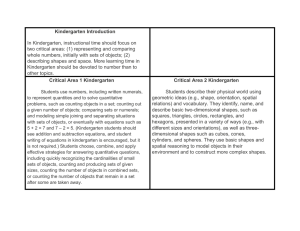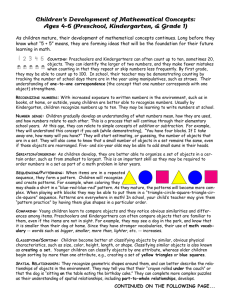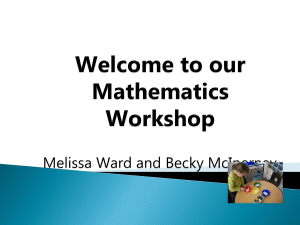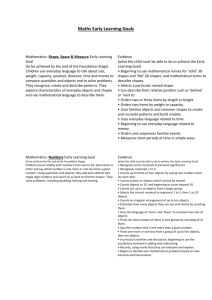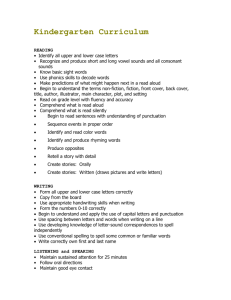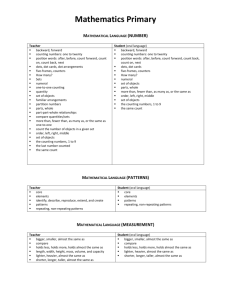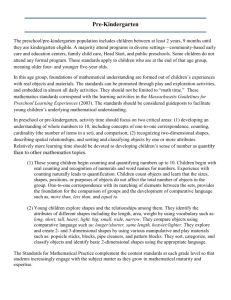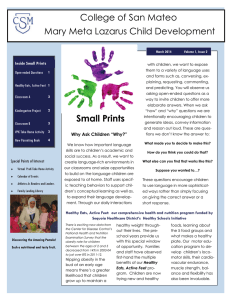Exploring Focus in the 2011 MA Curriculum Framework for
advertisement
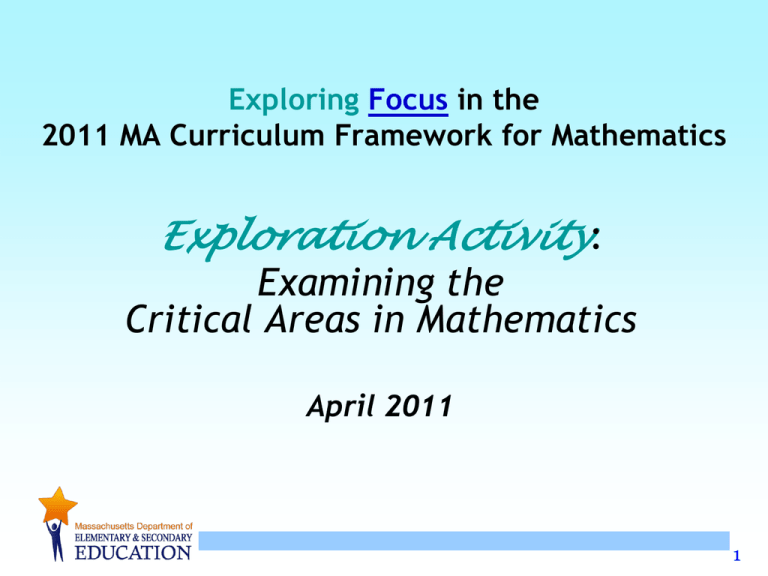
Exploring Focus in the 2011 MA Curriculum Framework for Mathematics Exploration Activity: Examining the Critical Areas in Mathematics April 2011 1 Desired Outcomes In this activity, participants will: • Become familiar with the Critical Areas for their grade level • “Unpack” the big ideas, skills and concepts for at least one Critical Area. • Understand how the Critical Areas help organize and bring focus to grade level standards. 2 Supporting changes in practice • The new standards support improved curriculum and instruction due to increased: – FOCUS, via critical areas at each grade level – COHERENCE, through carefully developed connections within and across grades – CLARITY, with precisely worded standards that cannot be treated as a checklist – RIGOR, including a focus on College and Career Readiness and Standards for Mathematical Practice throughout Pre-K-12 3 Critical Areas • There are typically two to four Critical Areas for instruction in the introduction for each grade level or course. • They bring focus to the standards at each grade by grouping and summarizing the big ideas that educators can use to build their curriculum and to guide instruction. 4 Example of a Critical Area _______________________________________________________________________________________ Kindergarten _______________________________________________________________________________________ In Kindergarten, instructional time should focus on two critical areas: (1) representing, relating, and operating on whole numbers, initially with sets of objects; and (2) describing shapes and space. More learning time in Kindergarten should be devoted to number than to other topics. (1) Students use numbers, including written numerals, to represent quantities and to solve quantitative problems, such as counting objects in a set; counting out a given number of objects; comparing sets or numerals; and modeling simple joining and separating situations with sets of objects, or eventually with equations such as 5 + 2 = 7 and 7 – 2 = 5. (Kindergarten students should see addition and subtraction equations, and student writing of equations in Kindergarten is encouraged, but it is not required.) Students choose, combine, and apply effective strategies for answering quantitative questions, including quickly recognizing the cardinalities of small sets of objects, counting and producing sets of given sizes, counting the number of objects in combined sets, or counting the number of objects that remain in a set after some are taken away. (2) Students describe their physical world using geometric ideas (e.g., shape, orientation, spatial relations) and vocabulary. They identify, name, and describe basic two-dimensional shapes, such as squares, triangles, circles, rectangles, and hexagons, presented in a variety of ways (e.g., with different sizes and orientations), as well as three-dimensional shapes such as cubes, cones, cylinders, and spheres. They use basic shapes and spatial reasoning to model objects in their environment and to construct more complex shapes. The Standards for Mathematical Practice complement the content standards at each grade level so that students increasingly engage with the subject matter as they grow in mathematical maturity and expertise. 5 Overview of Activities Warm up: • We will consider the impact of focusing our teaching and learning on a few key areas in each grade level (or course) (10 minutes) Main Activity: • In small groups, each person will search for standards within a grade level (or course) that connect to a particular Critical Area (20 min) – Combine results and discuss (15 min) • Debrief the experience as a whole group (10 min) 6 Warm-up Activity Please discuss in small groups and then share with the whole group: • How will/could it improve teaching and learning in our school/district when each grade focuses on a few Critical Areas? Grade level PK K 1 2 3 4 5 6 7 8 # of Critical Areas 2 2 4 4 4 3 3 4 4 3 Course Alg I Geo Alg II Math I Math II Math III # of Critical Areas 4 6 4 6 5 4 Time estimate: 10 minutes 7 Main Activity: Focusing on the Critical Areas Task 1: • In small groups, each member chooses a focus Critical Area and reads the description in the Framework. • Individually, read each content standard, marking the recording sheet with a: √ when a standard strongly matches your Critical Area and ? when you are not sure Task 2: • Transfer individual data to the Grade-Level Recording Sheet. Time estimate: 20 minutes 8 Main Activity: Grade-level Discussion Group members share a brief summary of their focus Critical Area. Referring to the group’s recording sheet, discuss: • Did every standard fall within a Critical Area? • Are there standards that fall within more than one Critical Area? • Do all the standards within a cluster fall within the same Critical Area? Time estimate: 15 minutes 9 Wrap-up Whole Group Discussion • How do the Critical Areas help organize and bring focus to your grade level standards? • How should we as a school (or district) use what we have learned today about Critical Areas in planning for the implementation of the new standards? Time estimate: 10 minutes 10 Feedback and Information • To provide feedback on this activity as a facilitator or participant, or to find more activities and resources, go to the ESE’s Curriculum and Instruction page at: http://www.doe.mass.edu/candi/commoncore/ 11
